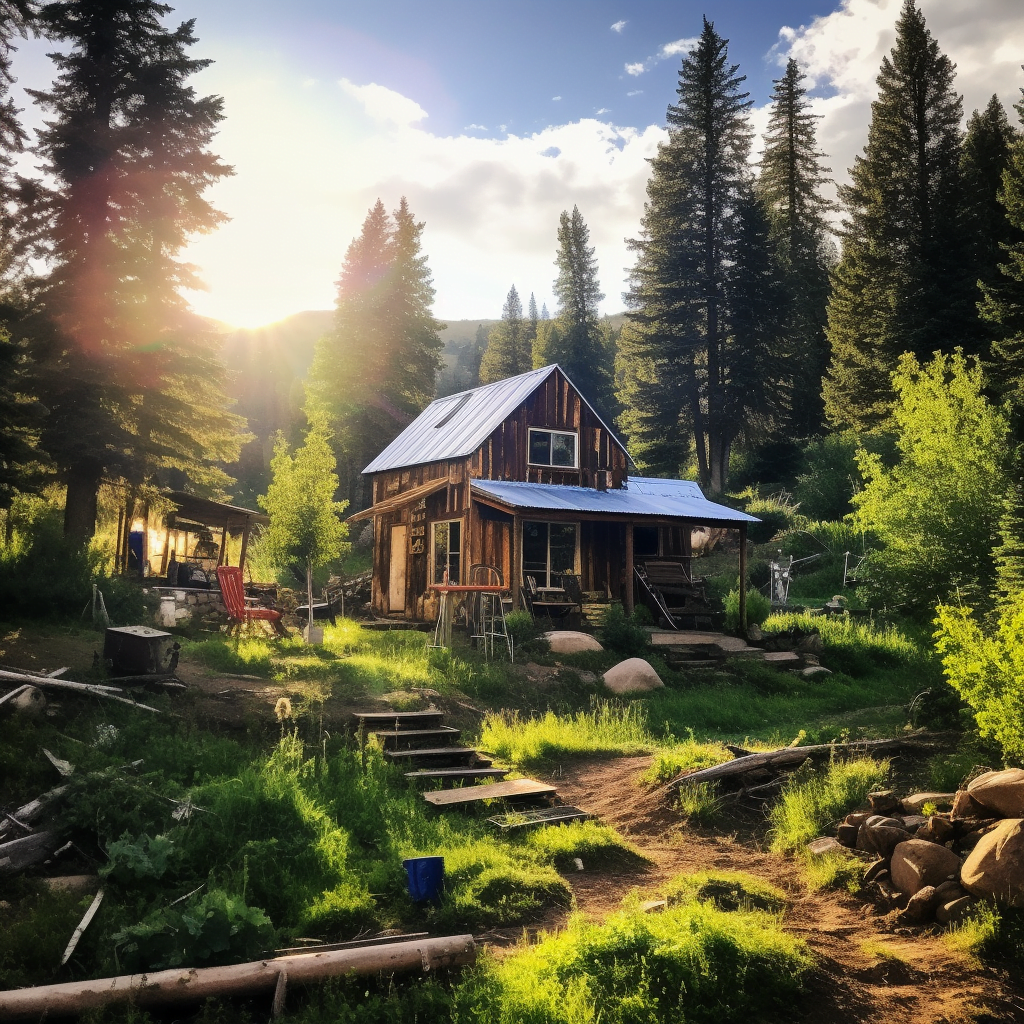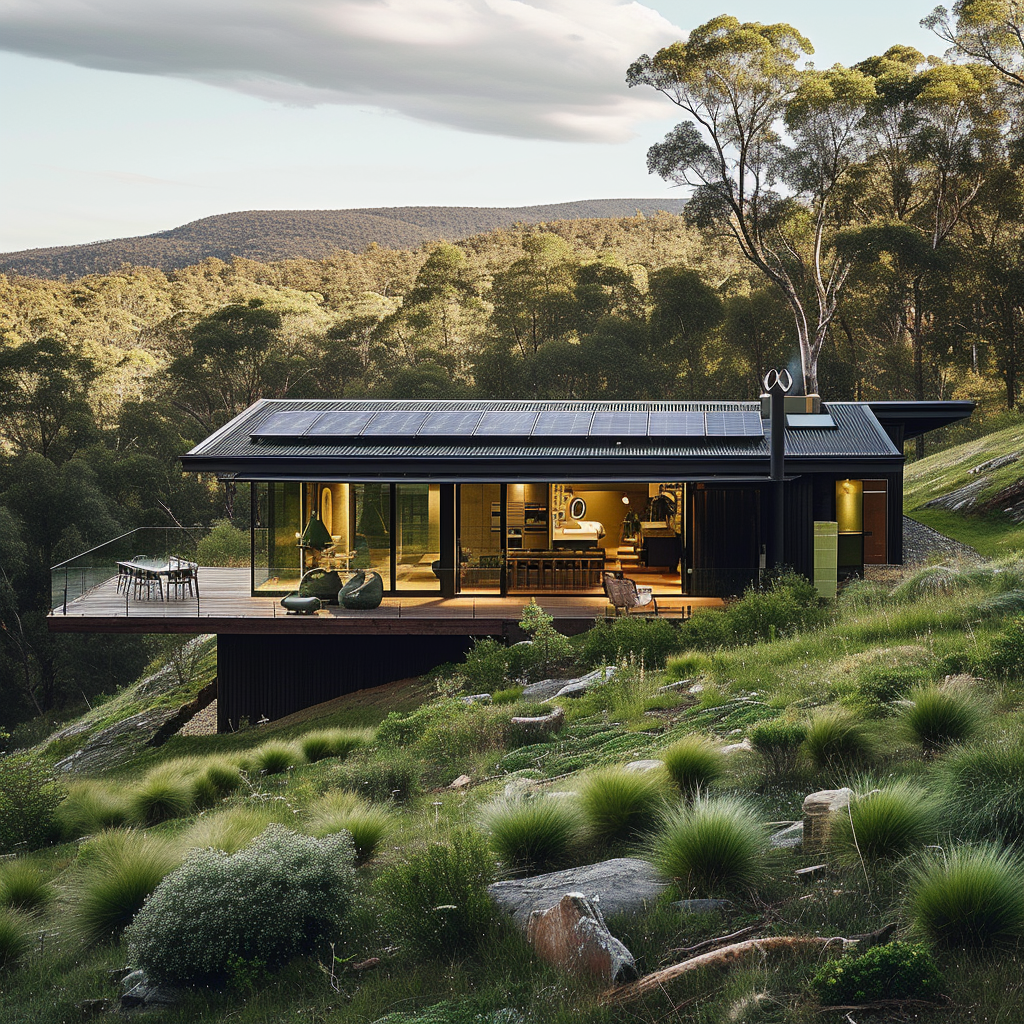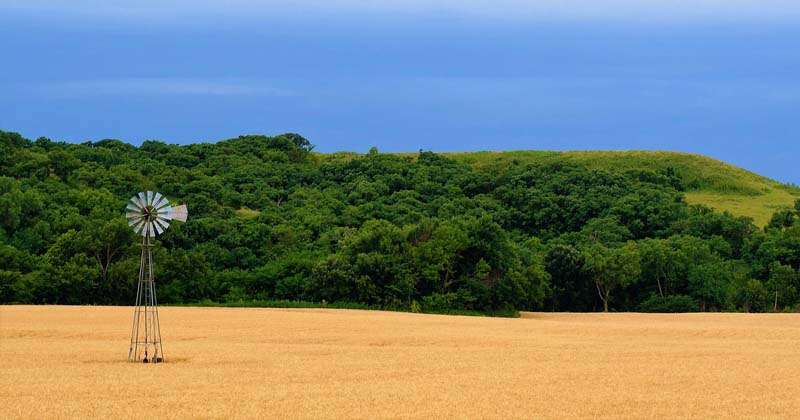Is Off-Grid Homesteading in Idaho Right for You?
Off-grid homesteading has seen a major resurgence in recent years as more people seek self-sufficient and sustainable living. Idaho offers excellent conditions for off-grid living with its low population density, affordable land, and abundance of fresh water. Going off-grid in Idaho can provide a rewarding way of life, but also comes with major challenges.
Here are some of the key benefits of off-grid homesteading in Idaho:
- Freedom and self-sufficiency – Being off-grid allows you to live life on your own terms without relying on municipal services. You become responsible for meeting your own water, power, and waste needs.
- Lower cost of living – You don’t have to pay for electricity, fuels, or other utility bills living off-grid. Homesteading and providing your own food cuts expenses.
- Sustainable living – Generating your own renewable energy and growing your food allows you to live a sustainable, low-impact lifestyle.
- Peace and quiet – Idaho has plenty of remote locations perfect for those who want privacy and solitude away from crowds.
However, off-grid homesteading also comes with many difficulties including:
- Hard work required for self-sufficiency
- Restricted access to healthcare and emergencies
- Lack of creature comforts and modern amenities
- Difficulty earning income remotely
- Unique challenges of off-grid life in extreme Idaho winters
Carefully consider if you have the skills and temperament to thrive in an isolated, off-grid setting before embarking on this lifestyle.
Choosing the Right Location in Idaho for Off-Grid Living
Selecting the ideal location is key for successfully homesteading off-grid in Idaho. Here are some important factors to consider:
Climate and Growing Conditions
Idaho ranges from semi-arid deserts to alpine forests. Evaluate annual rainfall, average temperatures, growing season length and hardiness zones when choosing your homestead location. Central and Northern Idaho offer more favorable growing conditions.
Terrain and Soil Quality
Look for relatively flat, tillable land with abundant ground water resources. Soil quality varies greatly, so test it for nutrients and suitability for crops.
Proximity to Towns and Services
While remote, some access to civilization is still important for off-grid homesteads. Try to reside within 15-30 miles of a town for periodic supply runs and emergency services.
Zoning, Building Codes and Permits
Research county zoning and codes thoroughly regarding off-grid construction, composting toilets, greywater systems and alternative energy. Some Idaho counties are very restrictive.
Affordability
While Idaho land is cheap compared to most states, finding truly affordable, livable off-grid parcels can be tricky. Look for deals on less desirable acreages.
The most suitable Idaho regions for off-the-grid living include:
- North/North Central Idaho – Abundant water, forests; moderate climate
- West Central Idaho – Sparsely populated; drier but good for solar power
- Eastern Idaho – Remote; bitter cold winters with harsh snow
Avoid highly restrictive areas like Blaine County and Sun Valley region. Thoroughly research zoning regulations before purchasing land.
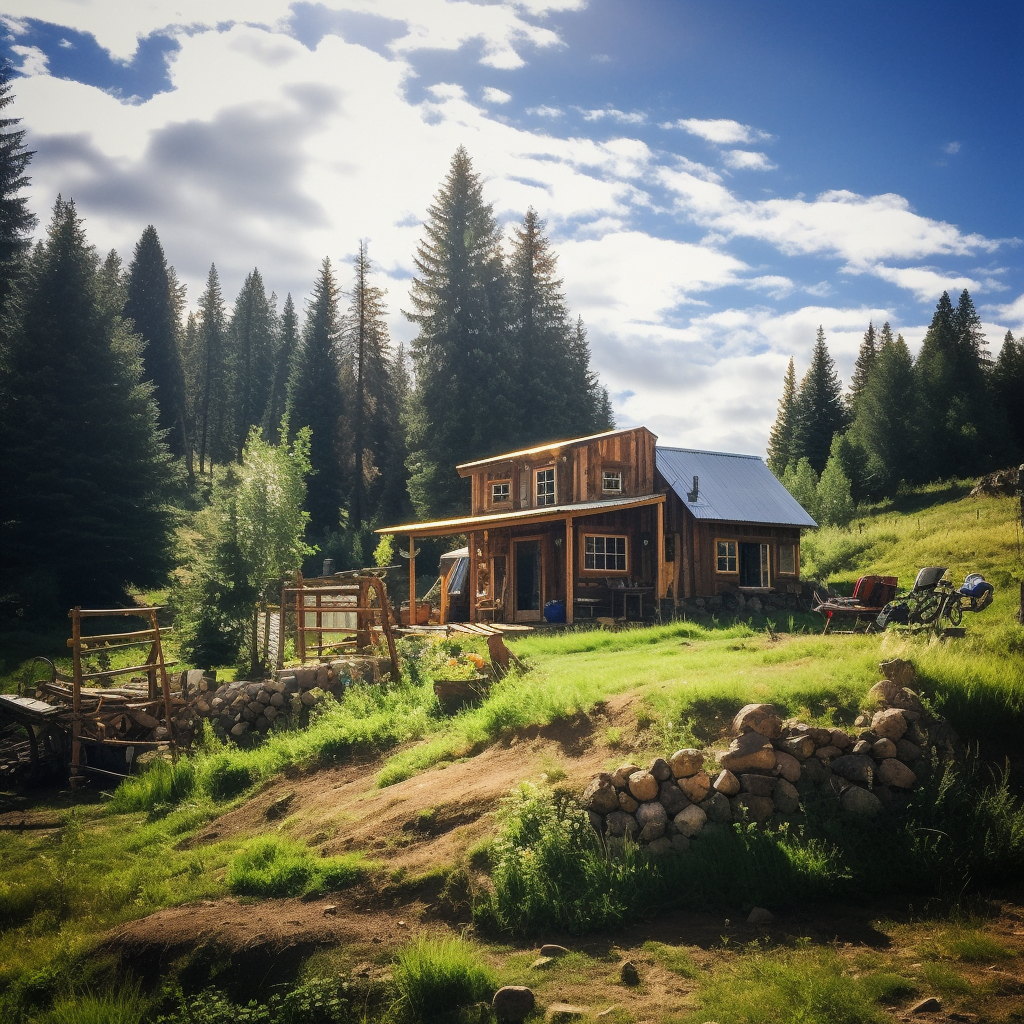
Building a Self-Sufficient Homestead in Idaho
To successfully homestead off-grid in Idaho, your residence and outbuildings must be constructed to function without any municipal utilities.
Off-Grid Cabin vs Retrofitting an Existing Structure
Building a simple cabin from scratch is one option for off-grid living. Alternatively, an existing farmhouse or barn can be retrofitted. Consider pros and cons:
| Off-Grid Cabin | Retrofitting Existing Structure |
|---|---|
| Cheaper if building yourself | Can be more affordable than new construction |
| Build to your exact specs | May have access to existing well, septic |
| Less red tape | Retrofitting can be complex, costly |
| Can be quite small and basic | Requires bringing structure fully up to code |
Off-Grid Power Systems
You’ll need to generate your own electricity living off-grid in Idaho. Here are some common options:
- Solar – Abundant sun in Idaho makes solar a top choice. Allows powering a broad range of appliances and equipment.
- Microhydro – Utilizes creeks, springs, or man-made water source to generate steady hydropower.
- Wind – Effective in windy plains and elevated areas. Pairs well with solar. Intermittent output.
- Generators – Can use propane or diesel generators for backup but fuel can be expensive.
To live comfortably off-grid, plan for at least 10-15 kW solar array with battery bank for storage.
Water Supply, Plumbing and Septic
Accessing water without a well requires rainwater harvesting, transporting water, and/or diverting flows from a stream or spring. Be sure to research your riparian water rights. A well is easier but requires the power to pump water.
Off-grid septic systems like composting toilets and greywater systems with mulch basins provide waste disposal without sewer lines. Follow codes for your county.
Heating Systems
To stay warm through Idaho’s bitter winters without electric or gas heat, opt for:
- Rocket mass heaters – Uses efficient wood burning
- Active solar heating systems
- Wood stoves
- Propane if you have backup generators
Prioritize high insulation, thermal mass, and passive solar design in your off-grid homestead.
Thriving with an Off-the-Grid Lifestyle in Idaho
Homesteading off the grid in Idaho is hugely rewarding but also challenging. Here are some tips for thriving:
Producing Your Own Food
With the right know-how and effort, you can grow or raise the majority of your family’s food. Key strategies include:
- Gardening – Grow staple crops, fruits, vegetables, and herbs in zones appropriate for your Idaho property. Use greenhouses and cold frames to extend the short growing season.
- Livestock – Chickens provide eggs while cattle, pigs, and sheep offer meat and milk. Rotate grazing pastures.
- Hunting/Fishing – Idaho has plentiful big game like deer, elk, and antelope. Requires proper licenses and land access.
- Foraging – Harvest wild berries and mushrooms. Know how to identify edibles.
Living Comfortably Off-Grid
It is possible to live pleasantly off the grid, but requires diligence:
- Adopt a minimalist, clutter-free lifestyle. Focus on necessities over luxuries.
- Manage energy and resources carefully. Limit usage during high-demand times.
- Allow abundance of natural light into structures during daytime.
- Cook, clean, and bathe efficiently with your limited water.
- Keep living space warm using thermal mass and insulation.
Income and Community
Two other key elements for sustainable off-grid living are:
- Remote income – If possible, earn money through computer-based work using satellite internet. Virtual assistant jobs or online creative work are options.
- Community – Isolation can be difficult. Seek or form an off-grid community with others who can help and provide a social network.
With ingenuity and grit, off-grid homesteaders can thrive in Idaho. But the lifestyle is not for everyone.
Handling Healthcare and Emergencies When Living Off the Grid
Medical care, security, and emergency response can be challenging off-grid. Strategize for these scenarios:
Medical Care and Health Insurance
- Live within 1 hour drive of a clinic or hospital if possible
- Establish a relationship with a doctor who makes house calls
- Get health insurance that covers rural providers and telehealth
- Keep first aid and common medicines well stocked
Security and Crime Prevention
- Install sensors, cameras, alarms and locks to secure the property
- Keep some guard dogs or livestock in residence
- Be wary of trespassers; do not open door to strangers
- Own a firearm if permitted; train on safe usage
Emergencies and Disasters
- Have backup generator, fuel supply, water, food for extended outages
- Know evacuation routes and locations of nearest shelters
- Keep fire extinguishers and firefighting tools available
- Install lightning rods, storm shutters, structural reinforcements
Homesteaders must be prepared to handle medical, security, and disaster response on their own. Consult with locals who have experience with off-grid living when making your preparations.
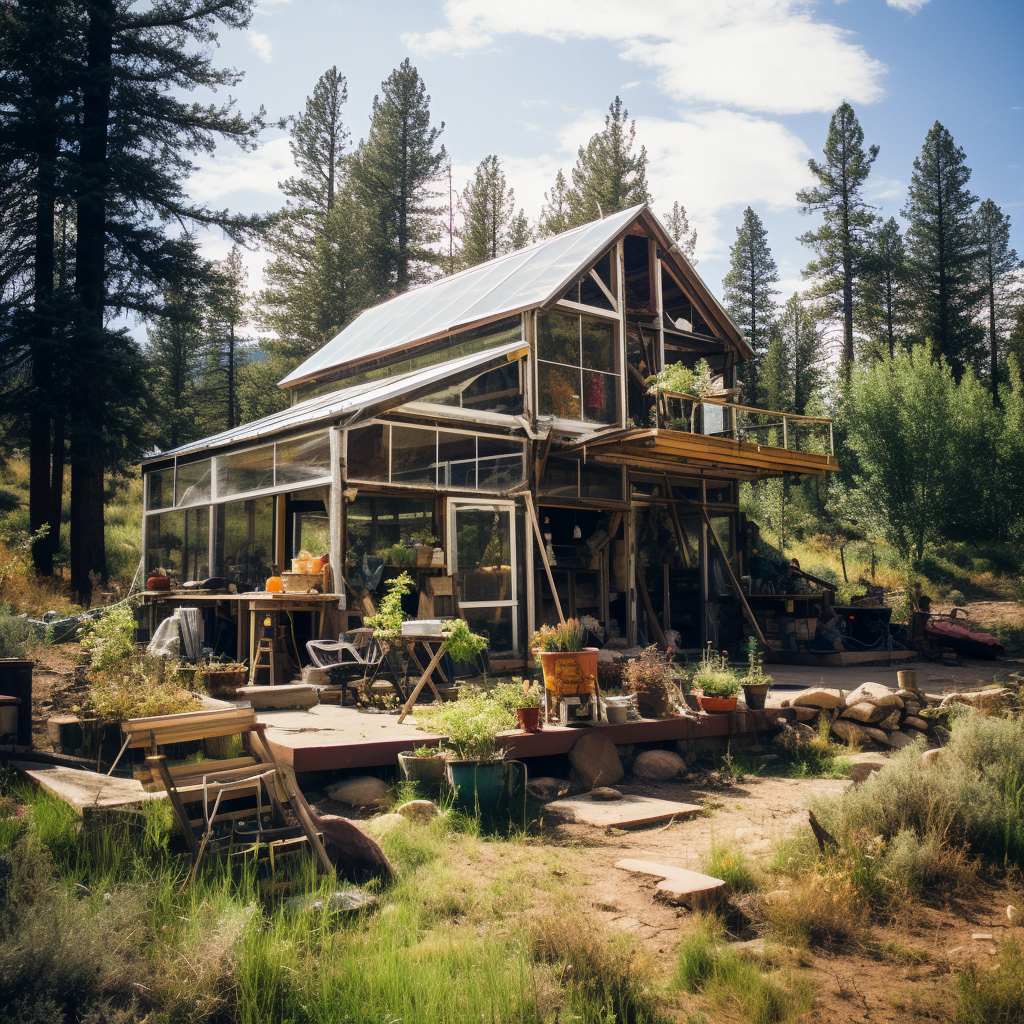
Is an Off-Grid Homestead in Idaho Right for You?
The off-grid homesteading life in Idaho offers independence, freedom, and sustainability – but requires huge dedication. Determine if you are ready for:
- Isolation and lack of urban amenities
- Performing intense physical labor
- Restricted healthcare and emergency response
- The commitment of a largely self-sufficient lifestyle
If you have the knowledge, skills and temperament required, an off-grid homestead can be
immensely rewarding. Here are some next steps if you feel ready to pursue off-grid homesteading in Idaho:
- Take a trip to Idaho to explore potential regions and connect with local off-grid homesteaders. See the conditions firsthand.
- Enroll in courses or apprenticeships on essential homesteading skills like gardening, livestock management, and off-grid construction.
- Research your target counties thoroughly regarding zoning, permits, and ordinances related to off-grid living. Understand the regulations.
- Develop a business plan for how you will earn remote income. Line up any necessary certifications or continuing education.
- Start purchasing vital supplies, tools, and equipment you will need such as solar panels, generators, gardening tools, food preservation materials, etc.
- Find land for sale that matches your criteria in your desired Idaho region. Retain a knowledge real estate agent who can help you identify parcels suitable for fully off-grid building and living.
- Design a comprehensive budget covering the costs of buying land, constructing your off-grid home and outbuildings, equipment, livestock, and operating capital covering at least the first two years.
- Connect with an established off-grid community in Idaho who can provide mentorship and support as you establish your homestead.
- Be prepared for setbacks and a steep learning curve. Managing an off-grid homestead requires tremendous resilience.
- Maintain your resolve. The idyllic, self-sufficient homesteading life exists for those bold enough to gut it out through the challenges and put in the hard work.
Key Takeaways – Off-Grid Homesteading in Idaho
Off-grid homesteading in Idaho offers an alluring opportunity for those seeking a self-reliant, sustainable lifestyle. But it also represents a dramatic shift with significant challenges.
If the freedom and rewarding challenge of living off your own land excites you, carefully weigh the commitment required. Thoroughly research locations in Idaho suitable for off-grid building. Realistically evaluate your adaptability and grit.
Be prepared to work harder than you ever have before. Homesteading necessitates constant, grueling effort to meet the basics of water, power, shelter, and food. But forging your own way on the land also brings deep purpose and satisfaction.
Idaho remains a rugged, lightly populated state with areas remote enough for off-grid sanctuaries. With luck and determination, it’s still possible here to live self-sufficiently if you have the right mindset, skills, and planning.
For the intrepid souls willing to live simpler and work with their own two hands, an off-grid homestead in Idaho offers the ultimate freedom. Be ready to embrace the challenge.

